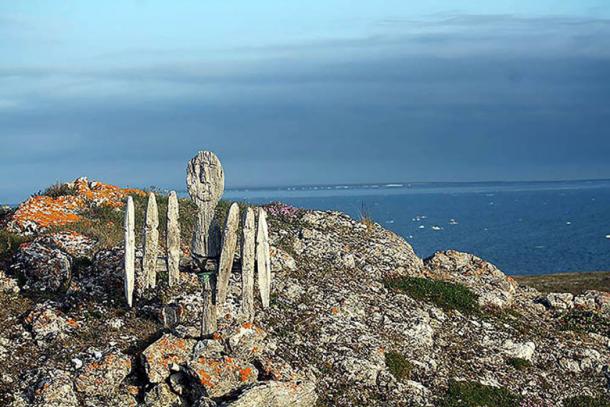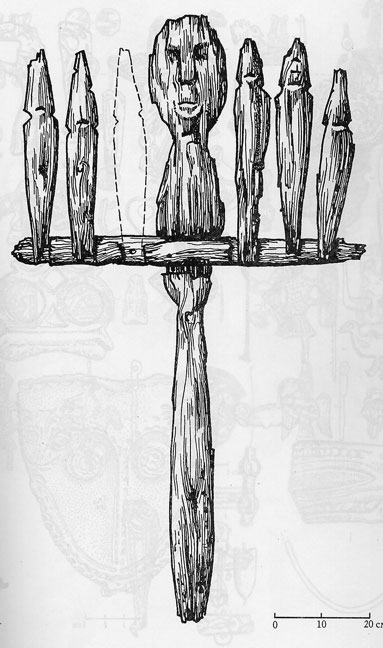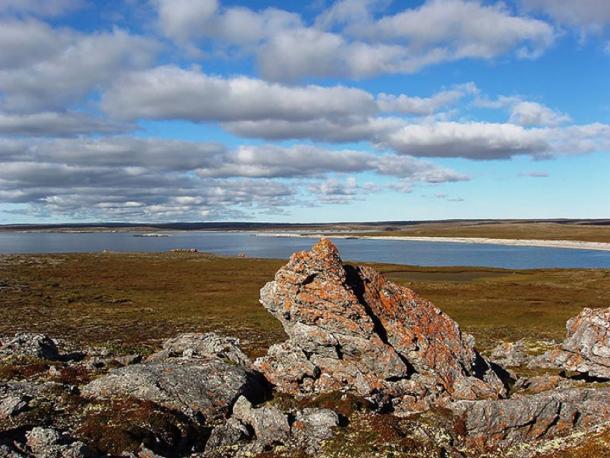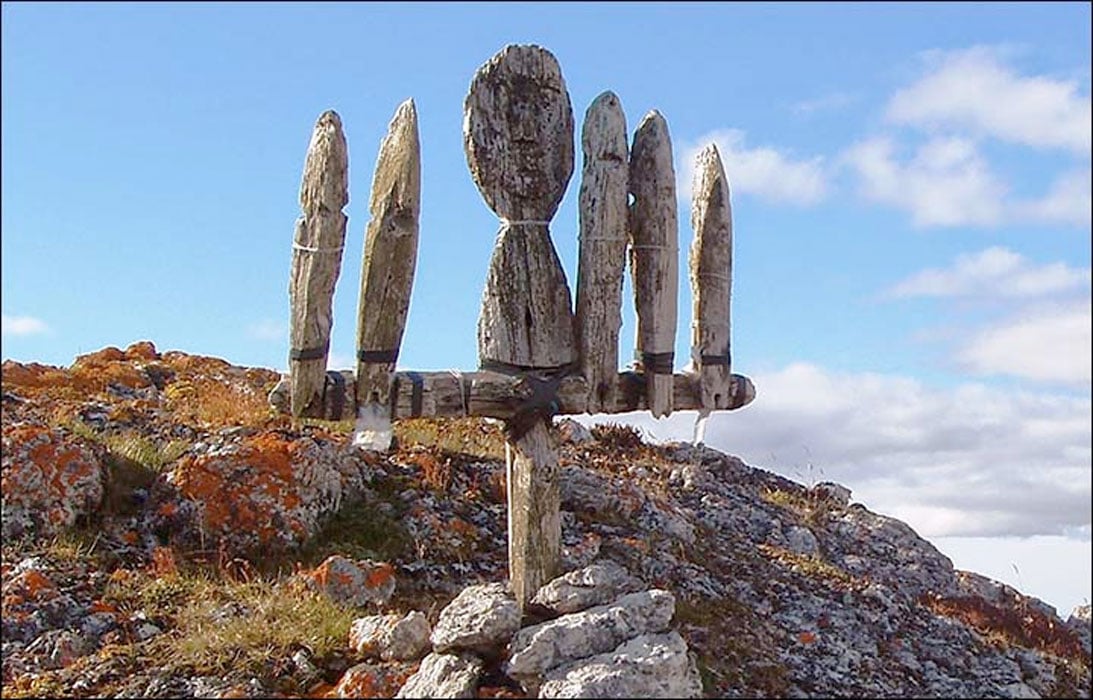The Curse of the Nenets Idols of Vaygach Island, the ‘Territory of Death’
By The Siberian Times reporter
For hundreds of years, visitors to this Arctic outpost have been frightened by terrifying totems and human sacrifices. With seven faces, this ancient wooden effigy stands 1.28 meters (4.4 ft) in height - and women are forbidden to approach it.
Bolshoi Tsinkovy is the largest of 111 small islands surrounding Vaygach, which is located between Barents and Kara seas. Here, still standing today, is the oldest idol of the native Nenets people, perhaps dating to the 18th century. It is the successor of many earlier eerie effigies, mostly on Vaygach Island of which Bolshoi Tsinkovy is a satellite.

Local history records that this idol originally stood on Vaygach island. Image: Artem Kazakov, The Siberian Times
One face represents Vesako, seen as the patron of hunters, and the others are his ‘demons’. Local history records that this idol originally stood on Vaygach island.

Google Map marked with the location of Vaigach Island (Image: The Siberian Times)
The Curse of the Nenets’ Idol
There are several legends that have grown around the haunting totem. During the times of Stalin, a bulldozer crushed the frightening image. Soon afterwards the vehicle’s driver died, or so it is rumored.
In 1997, the idol was taken by historian Dr Petr Boyarsky to St Petersburg for the restoration. According to accounts, the scientist suffered ill health and his museum ill fortune.
The idol came back in 2002 but the Nenets people were unhappy with the repair and carried out their own work on it.

In 1997, the Bolshoi Tsinkovy idol was taken by historian Dr Petr Boyarsky to St Petersburg for the restoration. (Image: The Siberian Times)
Idol Sacrifice
Yet it is long ago that outsiders venturing to Vaygach - its name means ‘terrible death’ or ‘territory of death’ in the local language - first felt the wrath of the idols found here.
English navigator Steven Borough visited in 1556 searching for a northern passage to India. Borough describes how a Russian showed him ‘a heap of Samoyeds idols’, a sight he described as ‘the worst and the most unartificial worke that ever I saw’.
He recorded how:
‘the eyes and mouthes of sundrie of them were bloodie, they had the shape of men, women and children, very grosly wrought, and that with they had made for other parts, was also sprinckled with blood’
In front of some of the idols stood stacks of blocks ‘as hight as their mouthes’, which ‘being all bloody’ were surmised by Borough to be ‘the table whereon they offered their sacrifice’.

Locals offer sacrifices to the idol. Images: Irina Khanzerova, Ilya Buyanovsky
They made sacrifices - sometimes even human. The murders were carried out secretly, as those doing the killing could be handed to the Russian authorities by other Nenets.
Now, as part of tradition, a reindeer is often sacrificed to the idol and locals regularly make offerings or gifts to it.

Exploring the Vaygach island in 2000, scientists from the Marine Arctic Complex Expedition found several sacred places. Images: Ivan Baryshev
Half a century later, a Dutch expedition seeking a route to China and India discovered 400 idols on what became known as the Cape of Idols on Vaygach.
Travelers also recorded local warriors here, guarding the idols.
Failed Attempt to End the Idol Worship
In 1827, Orthodox missionary, Archangelsk Archimandrite Veniamin, described the sacred place – before going on to destroy it:
'On the island of Vaygach since ancient times, two idols were worshiped. One, named Vesako, on the south end of the island. The other on the north is Hadako. Vesako was wooden, trihedral, thin and very old, two arshins high [1.4 m/13.1 ft].
Greatness was attached to this idol by 420 wooden idols standing several rows in half-circle. Of these, 20 were higher than others and had a height of 1.5 arshins [about 1 meter/ 3.3 ft].
Near them, 30 skulls of polar bears lay on the ground.
On the reindeer antlers were hangings: 22 small axes, which were so rusty that many of the necks completely fell off the blades; a few ears from copper kettles, buttons, iron nails and multi-coloured scraps.’
Some 100 meters away were 20 stone idols.
Veniamin destroyed the sacred place and ordered to burn the idols, but the Nenets people managed to keep many of them - and made new ones.

‘Here Samoyeds drove for thousands of miles, to sacrifice a deer at the foot of the dwelling of the lord of the polar deserts’. Images: Ilya Buyanovsky
In 1895 artist Alexander Borisov visited Vaygach and recounted:
“I often spoke with Samoyeds (telling them) it is not good to bring human heads to Syaday [the common name for all Nenets evil gods after they turned to Christianity], that it is immoral and contrary to the dictates of God, but they answered me:
‘Yes, and that's why we do what is against God. We do this not for God (Haya), but for Syadey (evil spirit, devil). And the devil likes that we do evil, and for this we will get many, many animals and fish’”.
Borisov persuaded Nenets to take him to the mountains and show idols hidden there. They did not agree for a long time, but finally gave in.
Here he found so many idols that, were he to remove them, he would have needed 30 or 40 carts.
Here too were piles of bounty found by the locals - ‘axes, knives, chains, fragments of anchors, obviously taken from the ships, crashed, harpoons, wreckage from rifles and locks, bullets.’
- The Great Serpent Mound of Ohio, the Largest Earthen Effigy in the World
- A Cycle of Life and Death: Slavic Goddesses Morana and Vesna
- 11,000 Years Old: New Dating of Shigir Idol reveals it is Oldest Wooden Sculpture in the World

Local Nenets Andrey Vylko repairs the idol. Image: Yamal RGO
‘Here Samoyeds drove for thousands of miles, to sacrifice a deer at the foot of the dwelling of the lord of the polar deserts. Many people think that Samoyeds do not do this now, but they are cruelly mistaken.’
Exploring the Vaygach island in 2000, scientists from the Marine Arctic Complex Expedition found several sacred places. For example, the sanctuary of Idol's mountain is located on one of the most visible peaks on a rocky ridge located in the interior of the island, in the basin of the Yunoyakha River.
Some five kilometers (3.1 miles) across the tundra are stone idols, built of flat stones, the highest some 2.5 meters (8.2 ft), sided with fragments of horns, bones and skulls.

‘It is surrounded on all sides by the sea, removed from the mainland and separated from it by a natural barrier - the Yugorsky Strait. (Image: The Siberian Times)
Dr Boyarsky said: 'Vaygach is the only sacred island on earth where no-one lived since ancient times, yet for many centuries were located the main sanctuaries of the peoples of the North. Therefore Vaygach for the history of mankind is no less important than the famous Easter Island. Apparently, Vaygach's position played a certain role here. It is surrounded on all sides by the sea, removed from the mainland and separated from it by a natural barrier - the Yugorsky Strait. From this point of view Vaygach is a kind of natural fortress, inaccessible, according to the Nenets, to the gentiles.’
Top image: Nenets idol on Bolshoi Tsinkovy island. Source: The Siberian Times
The article ‘Scary Arctic idols around Vaygach island, the ‘territory of death’ originally appeared on The Siberian Times and has been republished with permission.



















